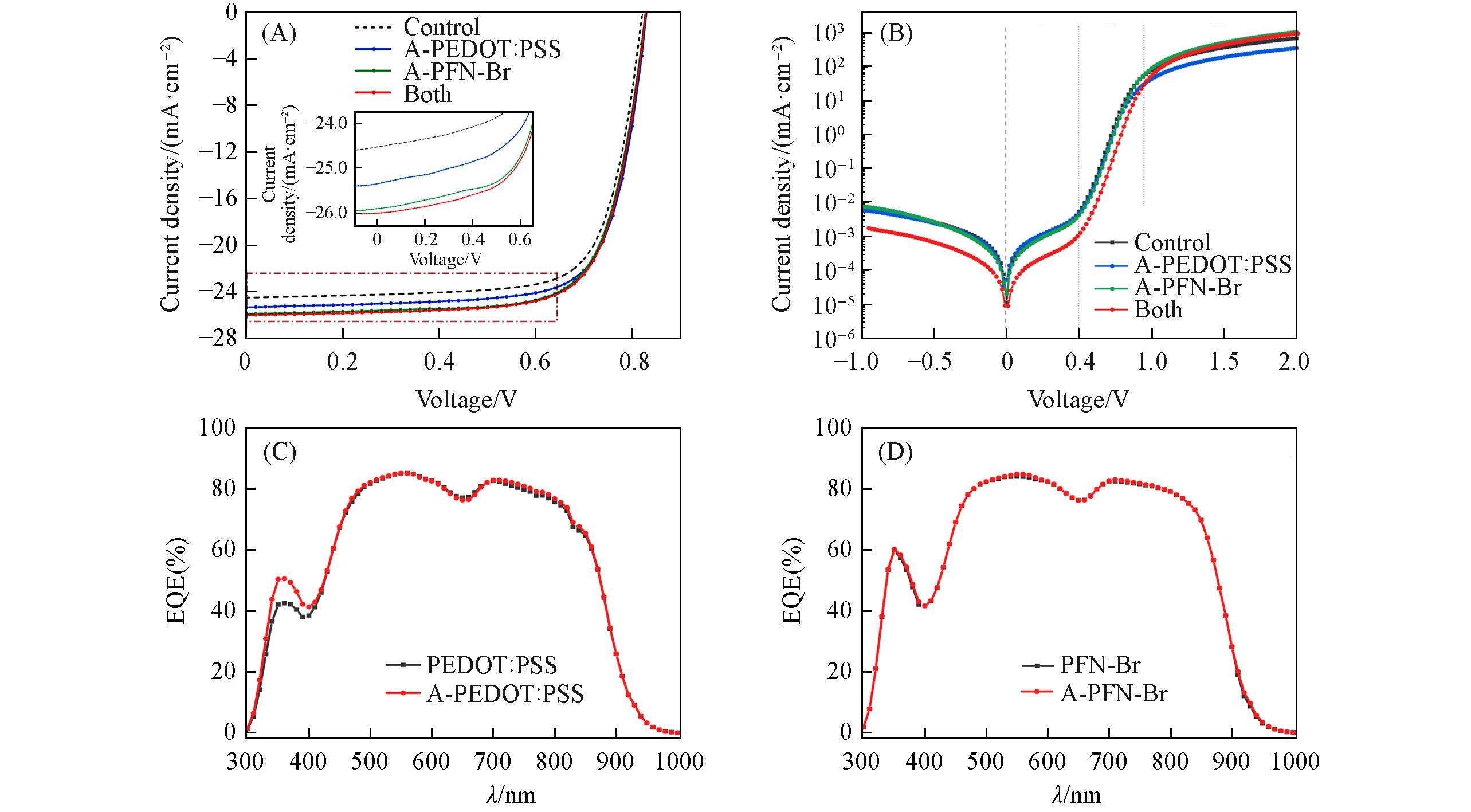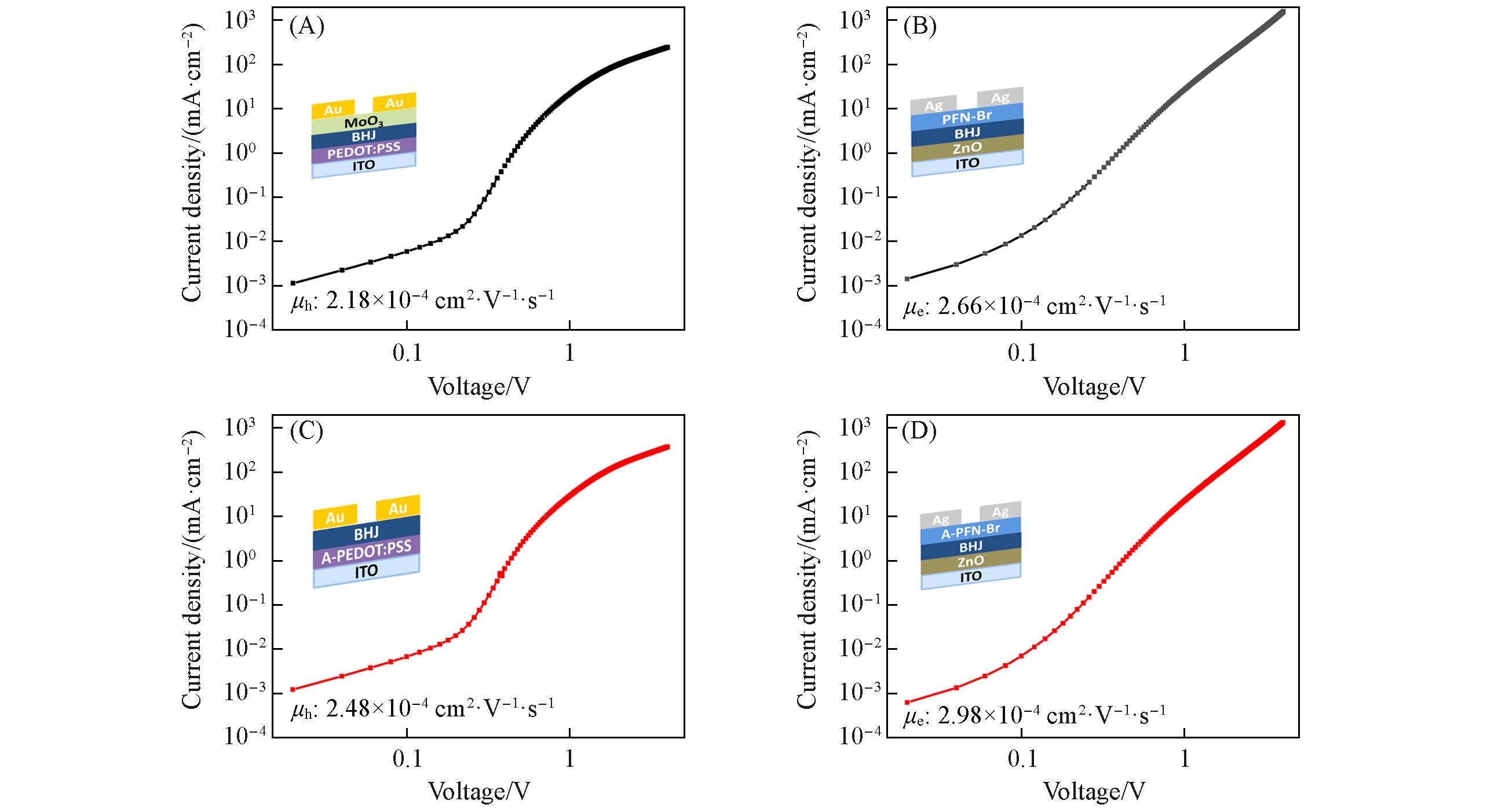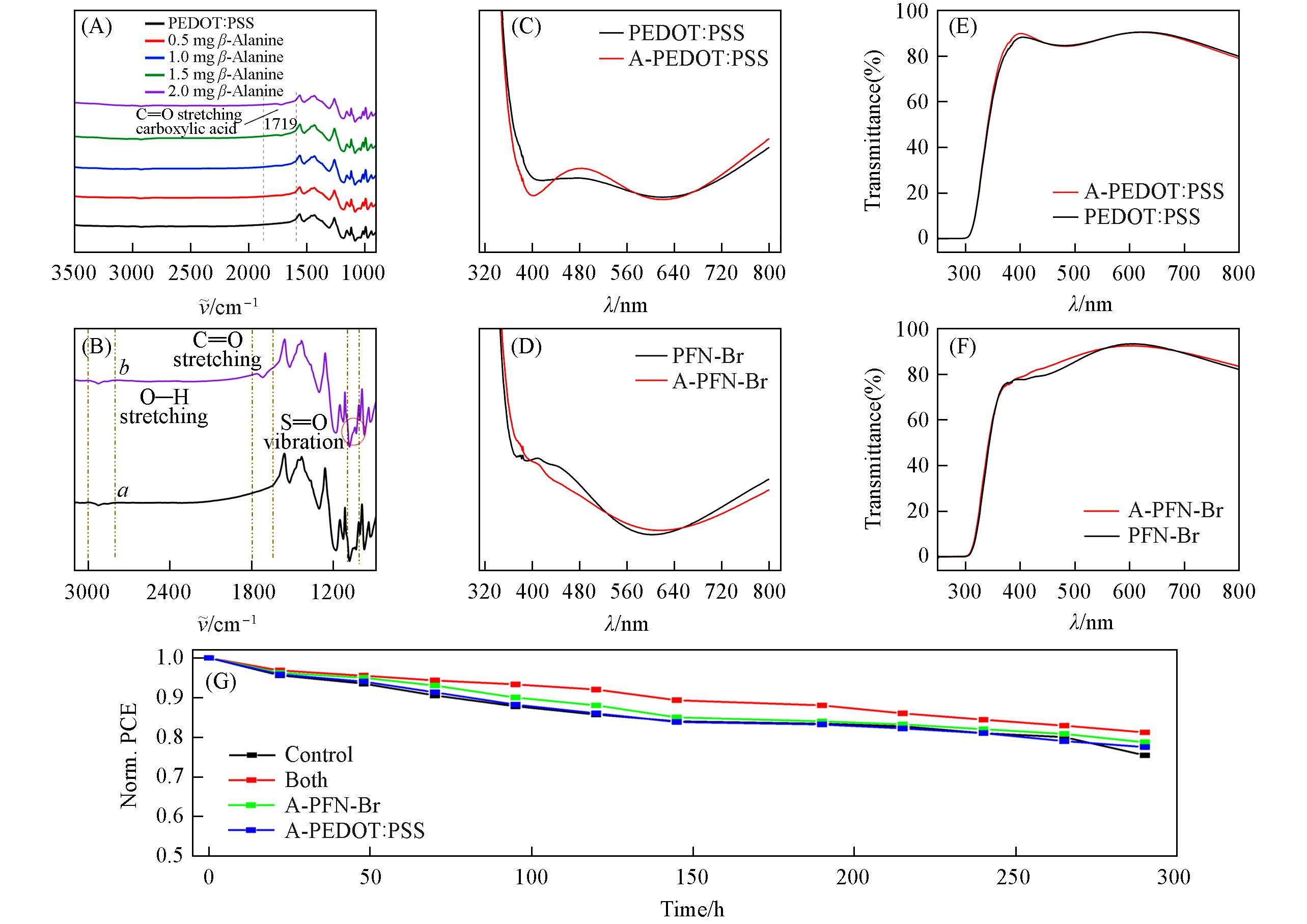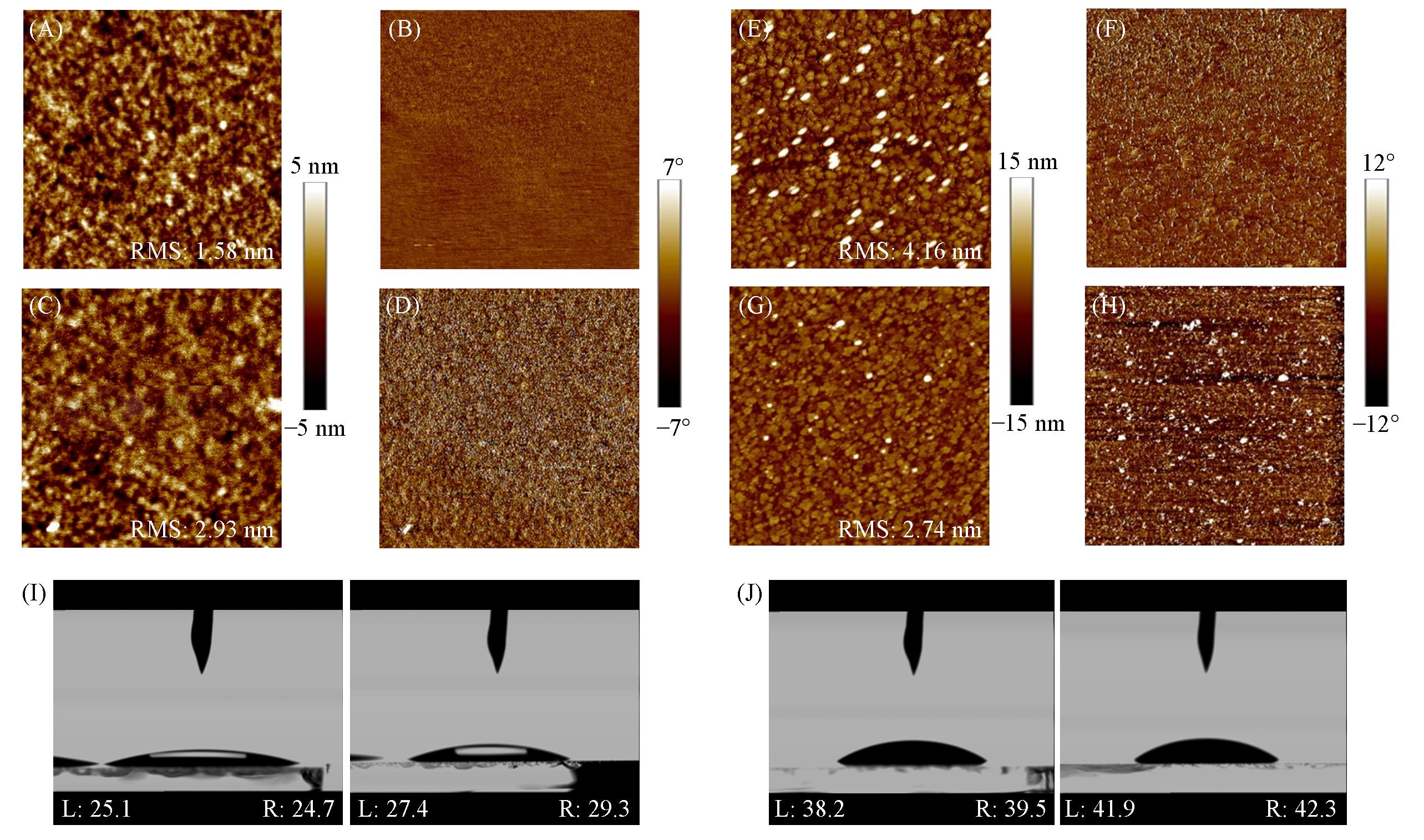

Chem. J. Chinese Universities ›› 2023, Vol. 44 ›› Issue (9): 20230185.doi: 10.7503/cjcu20230185
• Article • Previous Articles Next Articles
ZAFAR Saud uz1, ZHANG Weichao2, YANG Shuo3, LI Shilin2, ZHANG Yingyu1, ZHANG Yuan2, ZHANG Hong1( ), ZHOU Huiqiong1(
), ZHOU Huiqiong1( )
)
Received:2023-04-12
Online:2023-09-10
Published:2023-06-01
Contact:
ZHANG Hong, ZHOU Huiqiong
E-mail:zhanghong@nanoctr.cn;zhouhq@nanoctr.cn
Supported by:CLC Number:
TrendMD:
ZAFAR Saud uz, ZHANG Weichao, YANG Shuo, LI Shilin, ZHANG Yingyu, ZHANG Yuan, ZHANG Hong, ZHOU Huiqiong. Beta-alanine as a Dual Modification Additive in Organic Solar Cells[J]. Chem. J. Chinese Universities, 2023, 44(9): 20230185.

Fig.1 Chemical structures of β⁃alanine(A), PEDOT∶PSS(B) and PFN⁃Br(C), schematic illustration of mixing both transporting layers with β⁃alanine(D), schematic device structure representation of OSCs(E)
| BHJ System PM6∶Y6 | HTL/ETL | VOC/V | JSC/(mA·cm‒2) | FF(%) | PCE b (%) |
|---|---|---|---|---|---|
| Control | PEDOT∶PSS/PFN⁃Br | 0.821 | 24.52 | 74.43 | 14.99 |
| A⁃PEDOT∶PSS | With PFN⁃Br | 0.829 | 25.35 | 73.96 | 15.56 |
| A⁃PFN⁃Br | With PEDOT∶PSS | 0.827 | 25.91 | 73.39 | 15.65 |
| Both | A⁃PEDOT∶PSS/A⁃PFN⁃Br | 0.828 | 26.00 | 73.67 | 15.78 |
Table 1 Photovoltaic parameters of the conventional architecture of OSCs based on PM6∶Y6 system with pristine PEDOT∶PSS, PFN∶Br and modified versions with β ⁃alanine(A⁃PEDOT∶PSS and A⁃PFN⁃Br) a
| BHJ System PM6∶Y6 | HTL/ETL | VOC/V | JSC/(mA·cm‒2) | FF(%) | PCE b (%) |
|---|---|---|---|---|---|
| Control | PEDOT∶PSS/PFN⁃Br | 0.821 | 24.52 | 74.43 | 14.99 |
| A⁃PEDOT∶PSS | With PFN⁃Br | 0.829 | 25.35 | 73.96 | 15.56 |
| A⁃PFN⁃Br | With PEDOT∶PSS | 0.827 | 25.91 | 73.39 | 15.65 |
| Both | A⁃PEDOT∶PSS/A⁃PFN⁃Br | 0.828 | 26.00 | 73.67 | 15.78 |

Fig.2 Current density versus voltage(J⁃V) curves of PM6∶Y6 active layer using different ETL and HTL modified layers(control, A⁃PEDOT∶PSS, A⁃PFN⁃Br and both)(A), dark J⁃V characteristics of various devices(B) and EQE spectra for PEDOT∶PSS and A⁃PEDOT∶PSS(C) and for PFN⁃Br and A⁃PFN⁃Br(D)(A) The inset picture is a zoom-in on the curves.

Fig.3 SCLC carrier mobility graphs for hole transporting layers PEDOT∶PSS(A), electron transporting layer PFN⁃Br(B), modified HTL(A⁃PEDOT∶PSS)(C) and modified ETL(A⁃PFN⁃Br)(D)Insets are device architecture structures.

Fig.4 FTIR analysis of PEDOT∶PSS with different percentages of β⁃alanine(A), FTIR of pristine PEDOT∶PSS(a) and PEDOT∶PSS with 2.0 mg of β⁃alanine(b)(B), UV⁃Vis absorption of PEDOT∶PSS and A⁃PEDOT∶PSS(C), UV⁃Vis absorption of PFN⁃Br and A⁃PFN⁃Br(D), transmittance of PEDOT∶PSS and A⁃PEDOT∶PSS(E) and transmittance of PFN⁃Br and A⁃PFN⁃Br(F), the normalized stability graph of different devices(G)

Fig.5 AFM images of PEDOT∶PSS height(A), phase(B) and A⁃PEDOT∶PSS height(C) and phase(D), PFN⁃Br height(E), phase(F), A⁃PFN⁃Br height(G), phase(H), the contact angle(water) of PEDOT∶PSS, A⁃PEDOT∶PSS(I) and PFN⁃Br and A⁃PFN⁃Br(J)
| 1 | Zhou Z., Xu S., Song J., Jin Y., Yue Q., Qian Y., Liu F., Zhang F., Zhu X., Nat. Energy, 2018, 3(11), 952—959 |
| 2 | Gao W., Qi F., Peng Z., Lin F. R., Jiang K., Zhong C., Kaminsky W., Guan Z., Lee C. S., Marks T. J., Ade H., Jen A. K. Y., Adv. Mater., 2022, 34(32), 2202089 |
| 3 | Armin A., Li W., Sandberg O. J., Xiao Z., Ding L., Nelson J., Neher D., Vandewal K., Shoaee S., Wang T., Ade H., Heumüller T., Brabec C., Meredith P., Adv. Energy Mater., 2021, 11, 2003570 |
| 4 | Duan C., Huang F., Cao Y., Polym. Chem., 2015, 6(47), 8081—8098 |
| 5 | Wang J., Zheng Z., Zhang D., Zhang J., Zhou J., Liu J., Xie S., Zhao Y., Zhang Y., Wei Z., Hou J., Tang Z., Zhou H., Adv. Mater., 2019, 31(17), 1806921 |
| 6 | Du X., Heumueller T., Gruber W., Almora O., Classen A., Qu J., He F., Unruh T., Li N., Brabec C. J., Adv. Mater.,2020, 32(16), e1908305 |
| 7 | Che X., Li Y., Qu Y., Forrest S. R., Nat. Energy, 2018, 3(5), 422—427 |
| 8 | Yin Z., Wei J., Zheng Q., Adv. Sci., 2016, 3(8), 1500362 |
| 9 | Li Y., Ding J., Liang C., Zhang X., Zhang J., Jakob D. S., Wang B., Li X., Zhang H., Li L., Yang Y., Zhang G., Zhang X., Du W., Liu X., Zhang Y., Zhang Y., Xu X., Qiu X., Zhou H., Joule, 2021, 5(12), 3154—3168 |
| 10 | Chen M., Wang J., Yin F., Du Z., Belfiore L. A., Tang J., J. Mater. Chem. A, 2021, 9(8), 4505—4527 |
| 11 | Kalkan S. B., Najafidehaghani E., Gan Z., Apfelbeck F. A. C., Hübner U., George A., Turchanin A., Nickel B., npj 2D Mater. Appl., 2021, 5(1), 92 |
| 12 | Kang H., Hong S., Lee J., Lee K., Adv. Mater., 2012, 24(22), 3005—3009 |
| 13 | Liu M., Xu Y., Gao Z., Zhang C., Yu J., Wang J., Ma X., Hu H., Yin H., Zhang F., Man B., Sun Q., Nanoscale, 2021, 13(25), 11128—11137 |
| 14 | Wu J., Gao M., Chai Y., Liu P., Zhang B., Liu J., Ye L., Mater. Reports: Energy, 2021, 1(4), 100062 |
| 15 | Kim H. I., Bui T. T. T., Kim G. W., Kang G., Shin W. S., Park T., ACS App. Mater. Interfaces, 2014, 6(18), 15875—15880 |
| 16 | Zhang X., Zhang H., Li Y., Zafar S. U., Yang S., Chen J., Zhou H., Zhang Y., Adv. Funct. Mater., 2022, 32(44), 2205398 |
| 17 | Pei S., Xiong X., Zhong W., Xue X., Zhang M., Hao T., Zhang Y., Liu F., Zhu L., ACS App. Mater. Interfaces, 2022, 14(30), 34814—34821 |
| 18 | Zheng Z., Hu Q., Zhang S., Zhang D., Wang J., Xie S., Wang R., Qin Y., Li W., Hong L., Liang N., Liu F., Zhang Y., Wei Z., Tang Z., Russell T. P., Hou J., Zhou H., Adv. Mater., 2018, 30(34), 1801801 |
| 19 | Mengistie D. A., Chen C. H., Boopathi K. M., Pranoto F. W., Li L. J., Chu C. W., ACS App. Mater. Interfaces, 2015, 71, 94—100 |
| 20 | Zhang L., Yang K., Chen R., Zhou Y., Chen S., Zheng Y., Li M., Xu C., Tang X., Zang Z., Sun K., Adv. Electr. Mater., 2020, 6(1), 1900648 |
| 21 | Tang H., Liu Z., Hu Z., Liang Y., Huang F., Cao Y., Sci. China Chem., 2020, 63(6), 802—809 |
| 22 | Cassinelli M., Park W. T., Kim Y., Kim J. H., Noh Y. Y., Caironi M., App. Phys. Lett., 2021, 119(3), 033301 |
| 23 | Hu L., Song J., Yin X., Su Z., Li Z., Polymers, 2020, 12(1), 145 |
| 24 | Li B., Xiang Y., Jayawardena K. D. G. I., Luo D., Wang Z., Yang X., Watts J. F., Hinder S., Sajjad M. T., Webb T., Luo H., Marko I., Li H., Thomson S. A. J., Zhu R., Shao G., Sweeney S. J., Silva S. R. P., Zhang W., Nano Energy, 2020, 78, 105249 |
| 25 | Chen S., Song L., Tao Z., Shao X., Huang Y., Cui Q., Guo X., Org. Electr., 2014, 15(12), 3654—3659 |
| 26 | Liu D., Xu H., Liu X., Xie Z., Yang B., Ma Y., Chem. Phys. Lett., 2011, 514(1), 174—180 |
| 27 | Cameron J., Skabara P. J., Mater. Horizons, 2020, 7(7), 1759—1772 |
| 28 | Ionescu⁃Zanetti C., Mechler A., Carter S. A., Lal R., Adv. Mater., 2004, 16(7), 579 |
| 29 | Liao Q., Kang Q., Yang Y., An C., Xu B., Hou J., Adv. Mater., 2020, 32(7), 1906557 |
| 30 | Liu Y., Cole M. D., Jiang Y., Kim P. Y., Nordlund D., Emrick T., Russell T. P., Adv. Mater., 2018, 30(15), 1705976 |
| 31 | Li Y., Sci. China Chem., 2016, 59(11), 1430—1431 |
| 32 | Jia J., Fan B., Xiao M., Jia T., Jin Y., Li Y., Huang F., Cao Y., Macromolecules, 2018, 51(6), 2195—2202 |
| 33 | Hu Z., Chen Z., Zhang K., Zheng N., Xie R., Liu X., Yang X., Huang F., Cao Y., Solar RRL, 2017, 1(6), 1700055 |
| 34 | Guan L., Yu L., Wu L., Zhang S., Lin Y., Jiao Y., Zhang S., Zhao F., Ren Y., Zhou X., Liu Z., Thin Solid Films, 2021, 732, 138770 |
| 35 | Ming Y., Zhu Y., Chen Y., Jin B., Duan C., Liang Z., Zhao L., Wang S., Dong B., Li H., Wu C., ACS App. Mater. Interfaces, 2021, 13(48), 57163—57170 |
| 36 | Yuan H., Zhang Z., Guo T., Yu L., Deng Z., Zhao R., Zhang J., Zhu Y., J. Alloys Comp., 2021, 876, 160140 |
| 37 | Zheng Z., Zhang S., Zhang J., Qin Y., Li W., Yu R., Wei Z., Hou J., Adv. Mater., 2016, 28(25), 5133—5138 |
| 38 | Sun P., Liu Y., Du S., Yu B., Wang Y., Sun M., Shi P., Liu Y., Gong J., J. Mol. Liquids, 2017, 232, 522—531 |
| 39 | Zou F., Zhuang W., Wu J., Zhou J., Liu Q., Chen Y., Xie J., Zhu C., Guo T., Ying H., J. Chem. Therm., 2014, 77, 14—22 |
| 40 | Servaites J. D., Ratner M. A., Marks T. J., Ener. Env. Sci., 2011, 4(11), 4410—4422 |
| 41 | Servaites J. D., Yeganeh S., Marks T. J., Ratner M. A., Adv. Funct. Mater., 2010, 20(1), 97—104 |
| 42 | Wu N., Luo Q., Bao Z., Lin J., Li Y. Q., Ma C. Q., Sol. Energy Mater. Sol. Cells, 2015, 141, 248—259 |
| 43 | Wolf U., Arkhipov V. I., Bässler H., Phy. Review B, 1999, 59(11), 7507—7513 |
| 44 | Waldauf C., Scharber M. C., Schilinsky P., Hauch J. D., Brabec C. J., J. App. Phy., 2006, 99, 104503 |
| 45 | Zhou H., Zhang Y., Seifter J., Collins S. D., Luo C., Bazan G. C., Nguyen T. Q., Heeger A. J., Adv. Mater.,2013, 25(11), 1646—1652 |
| 46 | Lee B. R., Lee S., Park J. H., Jung E. D., Yu J. C., Nam Y. S., Heo J., Kim J. Y., Kim B. S., Song M. H., Adv. Mater., 2015, 27(23), 3553—3559 |
| 47 | Konwar L. J., Mäki⁃Arvela P., Mikkola J. P., Chem. Rev., 2019, 119(22), 11576—11630 |
| 48 | Hara M., Yoshida T., Takagaki A., Takata T., Kondo J. N., Hayashi S., Domen K., Angew. Chem. Int. Ed., 2004, 43(22), 2955—2958 |
| 49 | Li H., Zhang C., Ma Y., Mai Y., Xu Y., Org. Electr., 2018, 62, 468—473 |
| 50 | Aleshin A. N., Williams S. R., Heeger A. J., Syn. Metals., 1998, 94(2), 173—177 |
| 51 | Greczynski G., Kugler T., Salaneck W. R., Thin Solid Films, 1999, 354(1), 129—135 |
| 52 | Kemerink M., Timpanaro S., de Kok M. M., Meulenkamp E. A., Touwslager F. J., J. Phy. Chem. B, 2004, 108(49), 18820—18825 |
| 53 | Galatopoulos F., Papadas I. T., Ioakeimidis A., Eleftheriou P., Choulis S. A., Nanomaterials, 2020, 10(10), 1961 |
| 54 | Müller C., Hamedi M., Karlsson R., Jansson R., Marcilla R., Hedhammar M., Inganäs O., Adv. Mater., 2011, 23(7), 898—901 |
| 55 | Liao C., Zhang M., Yao M. Y., Hua T., Li L., Yan F., Adv. Mater., 2015, 27(46), 7493—7527 |
| 56 | Crispin X., Jakobsson F. L. E., Crispin A., Grim P. C. M., Andersson P., Volodin A., van Haesendonck C., Van der Auweraer M., Salaneck W. R., Berggren M., Chem. Mater., 2006, 18(18), 4354—4360 |
| 57 | Xu H., Yuan F., Zhou D., Liao X., Chen L., Chen Y., J. Mater. Chem. A, 2020, 8(23), 11478—11492 |
| 58 | Li W., Zhang W., Van Reenen S., Sutton R. J., Fan J., Haghighirad A. A., Johnston M. B., Wang L., Snaith H. J., Ener. Env. Sci., 2016, 9(2), 490—498 |
| 59 | Dag I., Lifshitz E., J. Phy. Chem., 1996, 100(21), 8962—8972 |
| 60 | Chang S. H., Chiang C. H., Kao F. S., Tien C. L., Wu C. G., IEEE Photo. J., 2014, 6(4), 1—7 |
| 61 | Hwang J., Schwendeman I., Ihas B. C., Clark R. J., Cornick M., Nikolou M., Argun A., Reynolds J. R., Tanner D. B., Phys. Review B, 2011, 83(19), 195121 |
| 62 | Akkerman H. B., Naber R. C. G., Jongbloed B., van Hal P. A., Blom P. W. M., de Leeuw D. M., de Boer B., Proceed. Nat. Acad. Sci., 2007, 104(27), 11161—11166 |
| 63 | Yun D. J., Jung J., Sung Y. M., Ra H., Kim J. M., Chung J., Kim S. Y., Kim Y. S., Heo S., Kim K. H., Jeong Y. J., Jang J., Adv. Elect. Mater., 2020, 6(11), 2000620 |
| 64 | Wang Q., Chueh C. C., Eslamian M., Jen A. K. Y., ACS App. Mater. Interfaces, 2016, 8(46), 32068—32076 |
| 65 | Hosseini E., Ozhukil Kollath V., Karan K., J. Mater. Chem. C, 2020, 8(12), 3982—3990 |
| 66 | Vorobyev A. Y., Guo C., Opt. Express, 2011, 19(Suppl 5), A1031 |
| 67 | Chao Y. C., Chen C. Y., Lin C. A., Dai Y. A., He J. H., J. Mater. Chem., 2010, 20(37), 8134—8138 |
| 68 | Li J., Wang N., Wang Y., Liang Z., Peng Y., Yang C., Bao X., Xia Y., Sol. Energy, 2020, 196, 168—176 |
| 69 | Shi Z., Liu H., Li J., Wang F., Bai Y., Bian X., Zhang B., Alsaedi A., Hayat T., Tan Z. A., Sol. Energy Mater. Sol. Cells, 2018, 180, 1—9 |
| 70 | Bi S., Leng X., Li Y., Zheng Z., Zhang X., Zhang Y., Zhou H., Adv. Mater., 2019, 31(45), 1805708 |
| 71 | Li Y., Zhang Z., Han X., Li T., Lin Y., CCS Chem., 2022, 4(3), 1087—1097 |
| 72 | Cha H., Wu J., Wadsworth A., Nagitta J., Limbu S., Pont S., Li Z., Searle J., Wyatt M. F., Baran D., Kim J. S., McCulloch I., Durrant J. R., Adv. Mater., 2017, 29(33), 1701156 |
| 73 | Lee S. J., Pil Kim H., Mohd Yusoff A. R. B., Jang J., Sol. Energy Mater. Sol. Cells, 2014, 120, 238—243 |
| 74 | Hermenau M., Riede M., Leo K., Gevorgyan S. A., Krebs F. C., Norrman K., Sol. Energy Mater. Sol. Cells, 2011, 95(5), 1268—1277 |
| 75 | Wang J., Yu H., Hou C., Zhang J., ACS App. Mater. Interfaces, 2020, 12(23), 26543—26554 |
| 76 | Mateker W. R., McGehee M. D., Adv. Mater., 2017, 29(10), 1603940 |
| 77 | Lin X., Wang Y., Wu J., Tang Z., Lin W., Nian L., Yi G., ACS App. Energy Mater., 2021, 4(6), 5905—5912 |
| 78 | Cho A., Kim S., Kim S., Cho W., Park C., Kim F. S., Kim J. H., J. Poly. Sci. B: PP., 2016, 54(15), 1530—1536 |
| 79 | Lee T. W., Chung Y., Adv. Funct. Mater., 2008, 18(15), 2246—2252 |
| 80 | Zhou Y., Fuentes⁃Hernandez C., Shim J., Meyer J., Giordano A. J., Li H., Winget P., Papadopoulos T., Cheun H., Kim J., Fenoll M., Dindar A., Haske W., Najafabadi E., Khan T. M., Sojoudi H., Barlow S., Graham S., Brédas J. L., Marder S. R., Kahn A., Kippelen B., Science, 2012, 336(6079), 327—332 |
| 81 | Mihailetchi V. D., Blom P. W. M., Hummelen J. C., Rispens M. T., J. App. Phys., 2003, 94(10), 6849—6854 |
| 82 | López Valdivieso A., Sánchez López A. A., Song S., Int. J. Miner. Process, 2005, 77(3), 154—164 |
| 83 | Paredes Á., Acuña S. M., Toledo P. G., Metals, 2019, 9(11), 1177 |
| 84 | Ouellette R. J., Rawn J. D., Organic Chemistry: Structure, Mechanism and Synthesis, Elsevier, Boston, 2015, 169—182 |
| 85 | Penczek S., Kubisa P., Allen G., Bevington J. C., Cationic Ring⁃opening Polymerization, Pergamon, Amsterdam, 1989, 751—786 |
| 86 | Savin K. A., Writing Reaction Mechanisms in Organic Chemistry, Academic Press, Boston, 2014, 1—53 |
| 87 | Li J., Huang X., Yuan J., Lu K., Yue W., Ma W., Org. Electr., 2013, 14(9), 2164—2171 |
| 88 | Hau S. K., Yip H. L., Acton O., Baek N. S., Ma H., Jen A. K. Y., J. Mater. Chem., 2008, 18(42), 5113—5119 |
| 89 | Chao L., Niu T., Gu H., Yang Y., Wei Q., Xia Y., Hui W., Zuo S., Zhu Z., Pei C., Zhang J., Fang J., Xing G., Li H., Huang X., Gao X., Ran C., Song L., Fu L., Chen Y., Huang W., Research, 2020, 2020, 2616345 |
| 90 | Yip H. L., Hau S. K., Baek N. S., Ma H., Jen A. K. Y., Adv. Mater., 2008, 20(12), 2376—2382 |
| [1] | WANG Jiacheng, CAI Guilong, ZHANG Yajing, WANG Jiayu, LU Xinhui, ZHAN Xiaowei, CHEN Xingguo. Simple Modulation of Side-chains of Near-infrared Absorbing Non-fullerene Acceptor for Higher Short-circuit Current Density [J]. Chem. J. Chinese Universities, 2023, 44(9): 20230163. |
| [2] | ZHANG Lifu, WANG Xinkang, CHEN Yiwang. New Strategy to Balance the Miscibility and Phase Separation to Improve Organic Solar Cells Efficiency [J]. Chem. J. Chinese Universities, 2023, 44(9): 20230177. |
| [3] | WANG Jiarui, YU Runnan, TAN Zhan’ao. Recent Advances in the Application of Metal Complexes for Organic Solar Cells [J]. Chem. J. Chinese Universities, 2023, 44(9): 20230150. |
| [4] | TIAN Mei, ZHANG Zhiyang, ZHAN Chuanlang. Fused-benzotriazole Based p-Type Polymers: Fine-tuning on Absorption Band-width and Bandgap via Backbone Thiophene and Selenophene Strategies [J]. Chem. J. Chinese Universities, 2023, 44(9): 20230190. |
| [5] | LI Hao, YANG Chenyi, LI Jiayao, ZHANG Shaoqing, HOU Jianhui. Efficient Organic Solar Cells Based on Acceptor1-acceptor2 Type Polymer Donor [J]. Chem. J. Chinese Universities, 2023, 44(9): 20230157. |
| [6] | ZHANG Yu, CHEN Jiehuan, ZHOU Jiadong, LIU Linlin, XIE Zengqi. Aggregation Morphology of Perylene Bisimide Acceptors and the Role on Exciton Processes and Electron Transport in Organic Solar Cells [J]. Chem. J. Chinese Universities, 2023, 44(9): 20230092. |
| [7] | SHI Shiling, JIANG Hanxi, TU Xueyang, XIAN Kaihu, HAN Dexia, LI Yanru, YAO Xiang, YE Long, FEI Zhuping. Synthesis and Photovoltaic Properties of Non-fullerene Acceptors Based on Aryl-substituted Imide End Groups [J]. Chem. J. Chinese Universities, 2023, 44(9): 20230182. |
| [8] | GUO Ziqi, JIAO Cancan, WU Simin, MENG Lingxian, SUN Yanna, KE Xin, WAN Xiangjian, CHEN Yongsheng. Effect of Substitution Positions of Alkyl Chains in Small Molecular Donor Bridged Units on the Performance of Photovoltaic Devices [J]. Chem. J. Chinese Universities, 2023, 44(9): 20230180. |
| [9] | YANG Hang, FAN Chenling, CUI Naizhe, LI Xiaoxiao, ZHANG Wenjing, CUI Chaohua. Cooperative Effect of Solvent Additive and Solvent Vapor Annealing on High-performance Thick-film Organic Solar Cells [J]. Chem. J. Chinese Universities, 2023, 44(9): 20230162. |
| [10] | SONG Xin, GAO Shenzheng, XU Shanlei, XU Hao, ZHOU Xinjie, ZHU Mengbing, HAO Rulin, ZHU Weiguo. Progress on the Efficiency Regulation of Organic Solar Cells by Volatile Solid Additives [J]. Chem. J. Chinese Universities, 2023, 44(9): 20230151. |
| [11] | WU Jifa, WU Hanping, YUAN Lin, PENG Xiaobin. Enhancing the Performances of Porphyrin-based All-small-molecule Ternary Organic Solar Cells via Synergizing Fullerene and Non-fullerene Acceptors [J]. Chem. J. Chinese Universities, 2023, 44(9): 20230136. |
| [12] | SONG Yanan, YOU Zuhao, WANG Xu, LIU Yao. Research Progress of Electroactive Ionene-based Organic Photovoltaic Interlayers [J]. Chem. J. Chinese Universities, 2023, 44(9): 20230167. |
| [13] | LI Wei, CHEN Chen, LIU Dan, WANG Tao. Hierarchical Aggregates of Non-fullerene Electron Acceptors [J]. Chem. J. Chinese Universities, 2023, 44(9): 20230160. |
| [14] | MA Yifan, ZHANG Yamin, GAN Shengmin, ZHANG Yuchen, FEI Xian, WANG Ting, ZHANG Zeqi, GONG Xuezhu, ZHANG Haoli. Ternary Organic Photovoltaic Devices Based on Wide-band Gap Small Molecule Donor Third Component [J]. Chem. J. Chinese Universities, 2023, 44(9): 20230170. |
| [15] | ZHANG Liting, QIU Dingding, ZHANG Jianqi, LYU Kun, WEI Zhixiang. Z-configuration A-DA'D-A Type Acceptor with Thermal Annealing Induced High Open Circuit Voltage [J]. Chem. J. Chinese Universities, 2023, 44(9): 20230164. |
| Viewed | ||||||
|
Full text |
|
|||||
|
Abstract |
|
|||||